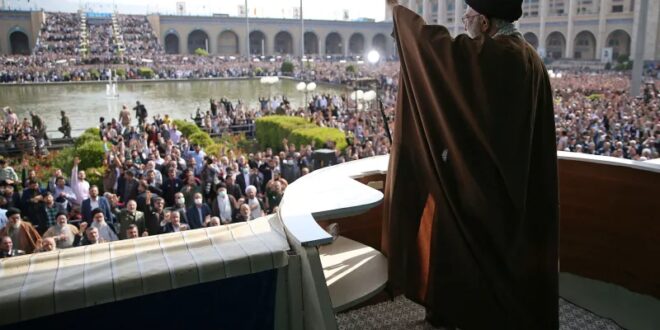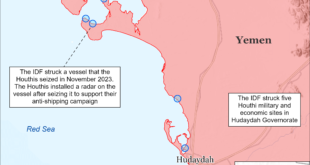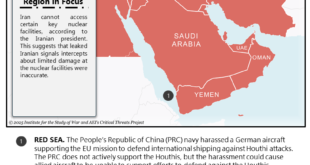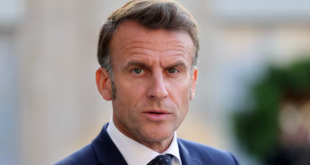The Race to Be the Next Supreme Leader Will Be Chaotic and Perilous
For most of the last nine months, outside analysts have looked to Iran’s protests for signs that the country might experience political change. These demonstrators, the vast majority of them young, certainly rocked the country’s elite with their cries of “Woman, life, freedom!” and their demands for democracy and a more open society. For a time, the protests were so large that outside analysts wondered if the Islamic Republic might simply collapse.
Alas, it was not to be. Tehran resorted to overwhelming force to quash the demonstrations, arresting thousands of protesters. It killed hundreds more, including via gruesome public executions. Today, embers of public discontent in Iran still smolder. But by and large, the demonstrations have subsided. They do not pose an imminent threat to the regime.
But the Iranian elite is not resting easy, if for a very different reason. Iran’s supreme leader, Ali Khamenei, is 84 years old and has a history of health problems. According to reporting by The New York Times, Khamenei was seriously ill last September. Traveling to a shrine in 2022, he told his entourage that it might be his last visit, given his age. He was treated for prostate cancer in 2014. Khamenei may be healthy now, but he will not live forever, and Iranian elites are worried about what will happen once he goes.
On paper, they shouldn’t be so concerned: the Islamic Republic’s formal system for choosing a supreme leader is quite straightforward. According to the Iranian constitution, the 88 members of the country’s Assembly of Experts will meet and nominate candidates. The Assembly of Experts has never disclosed the internal rules for these proceedings, but analysts know that the body deliberates for as long as it takes before voting, when it then eliminates candidates as needed until someone emerges with a majority.
But the actual process for choosing a new leader is not nearly so simple. Few of the assembly’s members—60 percent of whom are currently 70 or older—have real political clout. They are instead proxies for the regime’s leading politicians and policymakers, its security and military commanders, and the institutions they all dominate. This elite is riven with divisions and can struggle to reach consensus. Its members are, in fact, in near-constant conflict. Discord and fierce rivalry characterize the relations between and within every camp of the Iranian elites, who currently have no rule book, strong institution, or influential broker to manage their disputes.
Given all the mistrust and enmity, the struggle to succeed Khamenei is unlikely to be an orderly competition between the regime’s two major factions, moderates and hard-line conservatives. Indeed, it is unlikely to be orderly at all. Instead, the fight is likely to be much like the one that brought Khamenei to power in 1989: an ad hoc, transactional, and bitter contest. As different candidates battle, sudden alliances could emerge as quickly as they dissolve. Various elites could use the competition to settle scores, stab one another in the back, and air dirty secrets. The rules, insofar as they exist, will be manipulated. The ultimate winner could be a surprise to even the best-informed observers. The only certainty is that Khamenei’s death will bring great uncertainty—and chaos.
OUT OF THE BLUE
In the late 1980s, few people predicted that Khamenei would succeed Ayatollah Ruhollah Khomeini as Iran’s supreme leader. For starters, Khamenei, then a mid-ranking cleric, lacked the credentials constitutionally required to become the supreme leader. The country’s top religious figures suggested that he was a religious lightweight unable to divine Islamic rulings—no small charge in a state with theocratic characteristics. In a January 1988 open letter, even Khomeini said that Khamenei’s opinions were “against his sayings’’ and asserted that Khamenei did not have a correct understanding of the critical religious doctrine that justifies having a supreme leader to begin with.
Khamenei certainly had friends, and he had amassed enough power to be a contender for the top job—in large part by winning elections in 1981 and 1985 to become Iran’s president. But at the time, the presidency was largely a ceremonial role, devoid of any real authority. Khamenei belonged to the regime’s political right, which believed that the supreme leader was not above traditional religious laws and that the state should respect the independence of private businesses. In those years, however, the Islamic regime was mostly controlled by the left. This faction has morphed into today’s reformists, but at the time, they were defined by their push for an aggressive foreign policy, for purging all dissent, and for creating a highly centralized economy. They had won a landslide victory in the 1988 elections, gaining a supermajority in Iran’s parliament. The left’s young leader, Mir Hossein Mousavi, remained prime minister, and leftists dominated his cabinet. High-ranking judiciary positions, including the country’s chief justice and prosecutor general, were also in the left’s hands.
The left’s power extended beyond civilian institutions. A year earlier, in 1987, Khomeini surprisingly handed management of the Revolutionary Committees, then the country’s most terrifying domestic security force, to leftist operatives. The majority of the Iran Revolutionary Guards Corps’s rank and file either supported the left or Ayatollah Hossein Ali Montazeri, who was then officially designated Khomeini’s successor. The IRGC’s leadership itself was split between the right and the left, and Khomeini had recently asked two of its right-wing generals to be court martialed. Khomeini’s own inner circle, including his son, had a cozier relationship with the left.
In just a few years, Khamenei went from being a marginal actor to Iran’s unequivocal boss.
How Khamenei then managed to come out on top is one of the greatest mysteries of the Islamic Republic, in part because records of the subsequent Assembly of Experts proceedings remain a secret. But only two months before Khomeini’s death, the left successfully campaigned to remove Montazeri as Khomeini’s officially designated successor, creating a constitutional vacuum. The Assembly of Experts convened an emergency closed-door session. In the conclave, the members initially discussed having multiple top leaders instead of one but eventually rejected any power-sharing agreements. They then voted down the most prominent high-ranking clerics, including Ali Meshkini, the assembly’s chairman (whose powerful son-in-law then headed Iran’s intelligence service).
Eventually, according to historical accounts, members started suggesting random names, among them Ali Khamenei. Akbar Hashemi Rafsanjani, the speaker of parliament, threw his support behind Iran’s president. The right was still fragile, and some of its members voted against Khamenei. But the right managed to pick up some support from members on the left in order to elect him. How the right managed this task is still impossible to say. But Meshkini later described this “unexpected” outcome as “spontaneous divine intervention.”
After Khamenei was selected, a special council immediately revised Iran’s constitution to give the supreme leader an unprecedented absolute mandate to govern, which was then ratified in a controversial referendum. And once in power, Iran’s new supreme leader quickly purged his enemies. In his first three years of leadership, Khamenei expunged leftist officials from almost all key positions. He quickly appointed a new chief justice. He decommissioned and even imprisoned the IRGC’s nonconformist commanders. He succeeded in excluding the left from parliamentary elections. In fact, by the end of his second year, Khamenei had established a constricted vetting process that all national candidates had to pass through before they could run for office. In the span of just a few years, Khamenei went from being a marginal actor to Iran’s unequivocal boss.
ORDER OF DISORDER
Unlike other revolutionary regimes, such as those in China, the erstwhile Soviet Union, or Vietnam, the Islamic Republic never succeeded in establishing a party or other organization that could manage elite relationships. The two most important postrevolutionary political parties, the Islamic Republic Party and the Mujahideen Organization of the Islamic Revolution, dissolved in the 1980s because of internal disputes. The most prominent clerical organization, the Militant Clergy Association, was split in two by its right and left factions. Today, on paper, the elite has nearly 120 registered parties that claim to represent their interests, but none can count most of the elite as members.
The Islamic Republic, of course, has various state entities that in theory represent the entire country. But in practice, these bodies are in almost constant conflict. For the past two decades, for example, the Foreign Ministry and the IRGC’s Quds Force have fought over who would handle the country’s Afghanistan, Pakistan, and the Middle East foreign affairs portfolio. The battle goes on, even though both the ministry and the Quds Force are run by hard-line figures. In August 2022, the commander of the Quds Force even excluded the Foreign Ministry from organizing a meeting with the influential Iraqi Shiite cleric Muqtada al-Sadr. In April, the deputy chief of Iran’s insurance regulatory agency publicly encouraged the parliament to impeach the country’s industries minister. And Iran’s Ministry of Culture is at loggerheads with Iran’s national broadcasting service over who has the authority to censor the content of subscription streaming services.
Iranian elites will fight with one another even if it costs their factions opportunities.
Other conflicts rage within Iran’s institutions. In early 2021, for example, infighting within the IRGC’s political bureau prompted the dismissal of the head of the IRGC’s business conglomerate. (The ousted executive was then disqualified from running in presidential elections.) In February 2022, a leaked audio recording showed the IRGC’s commanders, including the powerful general Qasem Soleimani, killed in a U.S. air strike in 2020, brawling over their involvement in a massive case of financial corruption. Infighting within the Islamic Republic of Iran Broadcasting company has led to several changes in its senior leadership. Similar internal feuds have emerged among the hard-liners in charge of nuclear issues. The country’s chief nuclear negotiator, Ali Bagheri Kani, recently fell out with Saeed Jalili, his former boss, over a draft of the agreement that Kani supported. In response, Bagheri removed a Jalili supporter from the negotiation team.
In Iran, the informal power of elites has always been greater than that of formal bureaucratic organizations, which tends to make such interpersonal disputes more important than institutional conflicts. But these personal fights are rarely about policy divisions or ideological causes. Instead, private ambitions to gain power and control over public resources and economic rents drive conflicts among the elite. The selfish nature of these feuds means that elites will fight with one another even if it costs their factions opportunities. They will fight even if it undermines their ability to govern.
This was particularly evident during the June 2021 presidential elections. Some reformist leaders boycotted the election. Multiple conservative candidates spread rumors that the hard-line front-runner Ebrahim Raisi had been disqualified from the contest. They claimed, for example, that Khamenei had forbidden him to be a candidate.
Raisi eventually won. But disputes within the conservative elite were so intense that the president was not able to announce his choice of vice president until two months after his victory. It took him several more months to name a governor of the central bank as different interest groups within his camp competed for the seat. As Iran’s currency crashed, Raisi had to replace the bank governor in December 2022 with an individual affiliated with a different group.
UP FOR GRABS
Chaos in Iranian politics predates Khamenei. But the current supreme leader has done little to help instill order in the system. On the contrary, Khamenei has created a personalist type of rule under which the elite has never had a chance to develop entities and procedures that are capable of mediating their conflicts or aggregating their diverse interests. This in turn has made power precarious and led to constant churn. The elite thinks of state institutions not as venues for realizing organized political visions but as temporary fiefdoms in which they can exploit public resources and fulfill their individual objectives. Ironically, this also makes their institutional base of little use for their power-maximizing agendas.
Perhaps the best and the most recent example is Sadeq Amoli Larijani, Iran’s former chief justice, a former member of the Guardian Council (which can veto or amend legislation), and the current chairman of the Expediency Council (which resolves disputes between the parliament and Guardian Council). Despite all of his institutional positions, which many analysts assumed indicated that he was Khamenei’s successor, Larijani no longer has meaningful power. One of his confidents was sentenced to 31 years in prison for corruption. One of his main former appointees, the notorious public and revolutionary prosecutor Abbas Jafari, is now driving a cab in the streets of Tehran.
This volatility is likely to characterize the process by which Khamenei’s successor is chosen. It will be rather chaotic, with many spoilers and few sincere brokers. The candidates who seem to be favorites now, including Raisi and the supreme leader’s son, Mojtaba Khamenei, could quickly fall out of favor. Elites who have been spurned by the current political order will move to capitalize on Iran’s greatest power vacuum since 1989. That Iran is fertile ground for popular unrest only adds to the uncertainty.
Indeed, the only thing that is clear is that Iran’s contemporary elite is not prepared for this moment. It is rarely prepared for any turmoil—as the slow, halting, and then very violent response to the protests made readily apparent. Instead, when faced with crisis, the Iranian elite simply improvises and muddles along. Its struggles will not end when the succession process is over: the next leader of Iran is likely to be just as mercurial as the last.
 Eurasia Press & News
Eurasia Press & News



